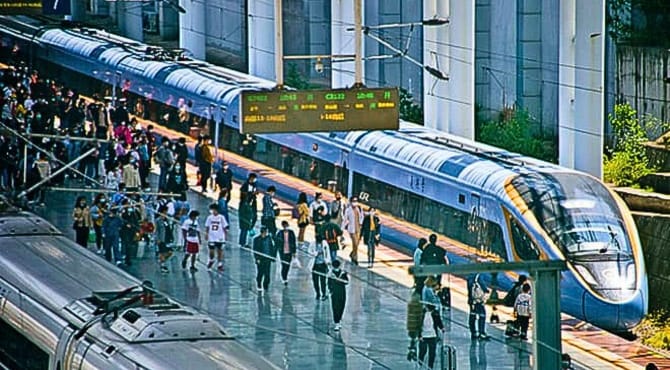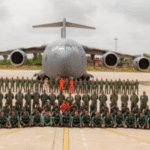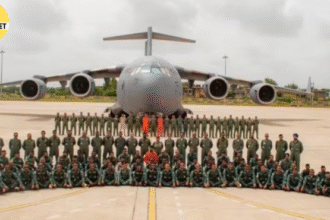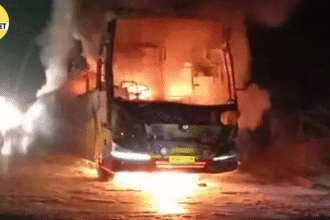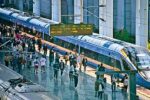Indian Railways has planned to build permanent holding areas at 76 high-traffic stations. While it appears as an ambitious infrastructural plan, the sprawling railway system of China has a lot to teach in terms of how efficient design and regulation of the flow of people can make the journey both easy and safe. You may ask; why China? The answer lies in the fact that China has a similar population which depends on rail network.
Indian Railways is embarking on a massive new project to construct permanent holding or waiting areas at 76 high-density stations across the country. The main objective is to be able to deal with the crowd of festivals, recruitment exams, and holiday trips more effectively.
This move was prompted by the successful and smooth festive rush management at Delhi Railway Station through the operation of such a holding area. India’s combined effort of matching its passenger volume with contemporary station design through such a move along with new technology and crowd-management measures is quite evident. When benchmarked against China’s cutting-edge railway stations, a number of similarities and differences become apparent.
Indian Railways’ big step forward
Railway Board had sent an 11-point action plan to be implemented by each zone. These points include:
- Creating waiting areas outside platforms
- Ensuring full access control to platforms
- Putting in place CCTV cameras, foot over-bridges (FOBs), and barricades
- Establishing monitoring war rooms, ticket vending machines, luggage scanners, and announcement systems
The order also mentions that travelers holding a confirmed and reserved ticket will be able to directly access the platforms, while those without a ticket or with a waiting list will be in the holding area until boarding.
As per the article, RITES Limited will be responsible for the design and RLDA for the development of these zones. The plan comprises 12 stations under the Northern Railway, eight under the Western, and six each in the Central, East Central, and South Central zones.
Prime Minister Narendra Modi has often stated, “Infrastructure for our people must be modern, safe and inclusive.” This new initiative is in line with that bigger idea – it is going to make rail travel more orderly, comfortable, and human-centered.
How China handles its crowds
One of the significant differences is that China has a very comprehensive and efficient railway system which can be a good benchmark for India. Chinese stations are equipped to deal with a large number of people at the same time since China has one of the largest and most crowded train networks in the world.
For example, Qiqihar South Railway Station in China has a waiting hall of nearly 30,000 square meters, which is designed to accommodate around 6,000 people at the same time. Likewise, Chongqing West Station is spread over about 120,000 square meters and is a multi-level structure for ticketing, waiting, and boarding. Research done by Chinese scholars shows that the waiting hall should not only be considered as a physical space, but also a main area that requires attention to lighting, sound, air flow, and the movement of people.
China’s rail hubs employ entry gates, huge concourses, electronic ticketing, and up-to-the-minute monitoring to handle passengers without any hassle. People stay in roomy, airy halls until their train is announced, which helps to minimize the number of people on platforms. These methods are the outcome of thorough planning from the very beginning – stations are constructed with the future in view and are mostly linked with metro lines and bus stations.
Lessons for India
India’s problem differs a bit from that of China’s as most of its train stations are old, are in the middle of heavily populated city areas, and require retrofitting rather than rebuilding. This makes it more difficult to deal with space. However, the new holding-area plan is a clever solution.
The most important lessons from China for India are:
- Design for flow, not just space. Clear routes, signs, and separation of ticketed vs. non-ticketed passengers are all very important.
- Focus on comfort. Good seating, air flow, lighting, and providing of conveniences will make people wait in a calm manner.
- Use tech wisely. Just like India, where surveillance, digital communication, and real-time crowd mapping are already implemented, these should be done very carefully.
- Integrate with the city. Besides the crowd situation on the platforms, linking rail stations with buses and metros will help to lessen the pressure in those places as well.
The new 76-station holding area plan of India as covered by The Indian Express is quite an essential and timely step. It demonstrates that the world’s largest democracy is taking lessons from the world’s most populous country – China – and applying them to its complicated railway network in a customized manner.
As a speaker at a railway upgrade event, Prime Minister Modi put it: “Our stations are not merely points along a route – they are tokens of progress and pride.”
In case the new Indian project really achieves its goals, the train riding experience could soon be felt as more organized, safer and quite a bit more comfortable by millions of everyday passengers – a huge step towards genuinely modern railway journeys.

